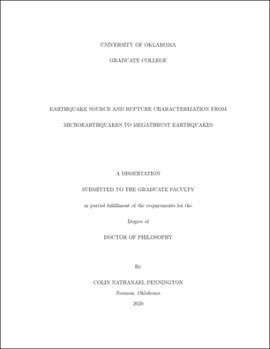Earthquake Source and Rupture Characterization from Microearthquakes to Megathrust Earthquakes *
Abstract
The understanding of earthquake rupture processes is vitally important to the proper estimation of hazard. I examine earthquake ruptures from megathrust earthquakes down to microquakes (< 3 magnitude) in order to better understand the role fault properties, prior seismicity, and injection play in controlling earthquake ruptures and if they change with magnitude.
In order to understand if the characterization of earthquake ruptures using source parameters such as stress drop, rupture size, and moment produce consistent interpretation no matter the method used to obtain them. To determine the effects of data selection and the method used to remove site and path effects have on source parameter estimates I examine the 2011 Prague earthquake sequence using a combined catalog of 5,446 earthquakes. From this analysis I find that the stress drop values will be systematically biased to a certain degree depending on how site and path effects are removed from the earthquakes waveform, and will also vary depending on the wave type used (P-wave, S-wave), and with the window length used to select the data. However, the normalized stress drop values are consistent, meaning that spatial and temporal interpretations of stress drops will be consistent across methods. Based upon this observation we interpret spatial patterns observed across all results and find that stress drops are affect by local fault structure and geology and the largest events slip distribution. These results suggest that source parameter interpretations can be interpreted reliably and reveal important information about fault systems, however in order to ensure that no method or data bias is included a second method of estimation should be used for verification.
To understand the controls on earthquake rupture and if they change across magnitude scales I perform 3 different types of analyses. Through the use of a finite slip inversion method I examine the slip distribution of a small Mw 4.1 earthquake in Guthrie Oklahoma and quantify its rupture by the number of slip patches that occur within it. To quantify the ruptures of large earthquakes I estimate their rupture complexity by the roughness of their Source Time Functions (STF), which represent an earthquake slip history in time, utilizing a global STF catalog. I examine microearthquake rupture using the high resolution borehole network along the Parkfield segment of the San Andreas fault. Microearthquake rupture complexity and simplicity is quantified in the frequency and time domain separately in order to examine if these observations agree. For each region and magnitude range examined I find ruptures that exhibit multiple phases in their slip history, which correlates to heterogeneity in the spatial distribution of slip on the rupture plans surface. The factors that are responsible for these more heterogeneous ruptures vary with region, but the ones that show the strongest effects are prior seismicity, heterogeneity in fault properties, and fault structure. The combination of the results from each of this separate analyses indicates that rupture complexity is not limited to large magnitude events, and the factors that control such ruptures for large magnitudes also control them for small and microearthquakes.
Collections
- OU - Dissertations [9477]
The following license files are associated with this item:

